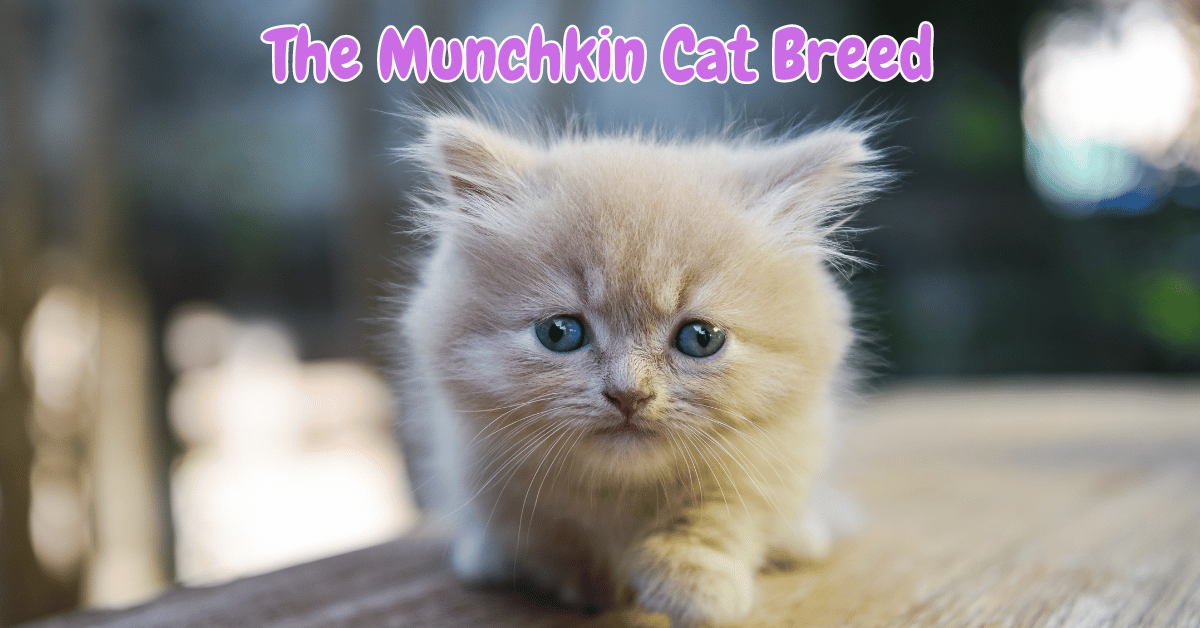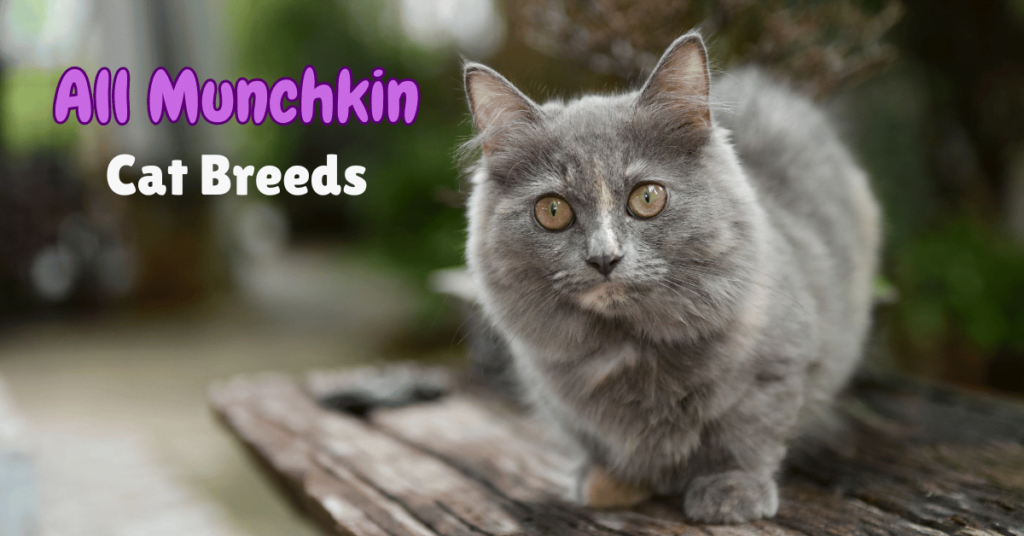This post contains affiliate links and I will be compensated if you make a purchase after clicking on my links.
Exploring the Munchkin Cat Breed
Meet the Munchkin—the adorable “mini-me” of the cat world, famed for their corgi-rivaling short legs and big personalities. These pint-sized felines pack a punch of energy and affection, making every room brighter with their playful antics.
As one of the notable short-legged hair breeds, Munchkin cats are not just a novelty; they’re loving pets known for their humorous, ferret-like sprints after toys and their quirky habit of sitting upright like little rabbits.
Despite some controversy over their breed status due to their unique physique, Munchkins continue to win hearts worldwide with their endearing characteristics and lively spirit. Join us as we delve into the world of Munchkin cats, where small stature meets enormous charm!
History and Origins of the Munchkin Cat Breed

Originating in Louisiana, USA, the distinctive Munchkin cat first made its appearance in 1983 within a litter of stray kittens. Though instances of short-legged cats were sporadically reported as far back as the 1940s, it wasn’t until a U.S. cat breeder named Sandra Hochenedel discovered a particularly short-legged cat, whom she named Blackberry, that the breed began to be intentionally developed. Blackberry’s progeny, consisting of half short-legged kittens, marked the official beginning of the Munchkin breed.
Named after the diminutive characters from “The Wizard of Oz,” Munchkins have waltzed their way into the hearts of cat lovers, thanks to their unique appearance and spirited nature.
Despite their popularity, the breed’s recognition has been a point of contention. It wasn’t until 2003 that Munchkins achieved official breed status and TICA championship status from The International Cat Association. To date, they remain unrecognized by the Cat Fanciers’ Association. However, they are accepted by the Southern Africa Cat Council, highlighting regional differences in breed acceptance
Physical Characteristics of the Munchkin Cat Breed
Munchkin cats are often described as the social butterflies of the cat world, flaunting an engaging personality within their petite frames. Weighing between 5 to 9 lbs (2.3 to 4 kg) and measuring up to 18 inches in body length, Munchkins present a charming compactness that is hard to resist.

The genetic blueprint of a Munchkin cat includes a unique autosomal dominant gene responsible for their hallmark short legs. This gene is not linked to the cat’s sex and will manifest whether inherited from one or both parents.
However, inheriting this gene from both parents proves lethal, as those embryos do not survive. Consequently, breeders only mate Munchkins with regular domestic cats to maintain genetic diversity and health. Such matings typically result in litters where the kittens have an equal likelihood of being Munchkins or regular-legged cats.
Munchkins are medium-sized with a moderate body type and a head shape that is neither too round nor too pointed. Their coat, which can be short, medium, or long, is thick and plush, contributing to their cuddly appearance. Noteworthy coat patterns include solid, tabby, calico, tortoiseshell, and bicolor, while eye colors range through shades of blue, brown, copper, green, and yellow. The breed’s eyes are characteristically walnut-shaped and set wide apart, enhancing their expressive faces.


Despite their short legs, which give them a distinctive long and low silhouette, many Munchkins are quite capable of jumping. However, their movement is uniquely characterized by a wriggly, rolling motion, differentiating them from their longer-legged counterparts.
Within the breed, there are variations in leg length: standard Munchkins have slightly shorter legs; super-short Munchkins have legs 2 to 3 inches shorter than normal; and the rug huggers possess the shortest legs, keeping them very close to the ground.
Fun Fact: Did you know that according to the breed standard, Munchkin cats can only be crossbred with domestic longhair or shorthair cats that aren’t part of any recognized breed? If a Munchkin cat doesn’t carry the heterozygous gene (meaning a cell has two different alleles of a gene), they strut into the world sporting standard-length legs!
Munchkin Personality and Temperament

Munchkin cats, affectionately nicknamed “Sausage Cats” or “Kangaroo Cats” due to their distinctive short legs and upright posture, embody a delightful mix of curiosity and playfulness. These cats are known for their sociable nature and a certain dependency that makes them crave constant companionship, making them less suited for bustling family homes but perfect for environments that can provide a calm and nurturing space.
The Munchkin’s personality is multifaceted; they cherish handling and lap-time perhaps more than the average cat, enjoying cuddles and affection. Yet, they are not ones to forgo their innate feline instincts. Given the opportunity, they will eagerly engage in chasing and hunting toys, displaying the full range of their hunting prowess. This blend of affection and activity ensures that they are never boring companions.
As specialist cats, Munchkins thrive in homes where owners are frequently present. While they might not be the ideal choice for families with very young children, they are excellent companions for older kids who can appreciate and respect their limitations and unique characteristics.
Their friendly disposition makes them excellent additions to diverse and multi-pet households, where they often become fast friends with both feline and canine companions. This ability to integrate well with other pets adds to their charm and makes them a wonderful option for a peaceful, loving home environment.
Fun Fact: Munchkin Cats are known for their penchant for collecting small, shiny objects, which has earned them the nickname “magpies of the cat world.” These little treasure hunters just can’t resist a bit of sparkle.
Munchkin Cats: Health Insights and Lifespan
The Munchkin cat breed, with a lifespan typically ranging from 12 to 15 years, sparks a significant ethical debate due to its defining short-legged gene mutation. While many in the cat community view Munchkins as generally healthy, free from major skeletal issues typically associated with dwarfism, there remains a strong voice of concern regarding the promotion of a genetic trait that may lead to health complications.
Common Health Concerns in Munchkins:
- Lordosis: The most critical health issue in Munchkins is lordosis, where there is a severe dip in the spinal column near the shoulder blades. This condition can compress internal organs, leading to respiratory difficulties and, in severe cases, compression of vital organs causing significant discomfort and potentially premature death.
- Osteoarthritis: These cats are at a higher risk for osteoarthritis, particularly due to their abnormal leg and spine structure. Early signs might include reluctance to jump or play, which for a Munchkin, might be less noticeable given their natural limitations.
- Pectus Excavatum: This condition results in a hollowed chest, which can further complicate the respiratory issues associated with lordosis.
- Hyperthyroidism, Diabetes, and Heart Problems: Munchkins, like other breeds, can suffer from common feline ailments such as hyperthyroidism, diabetes, and various heart conditions, which require careful monitoring and management.
- Kidney and Urinary Tract Diseases: Feline lower urinary tract disease and kidney issues like uremia are concerns that can affect Munchkins, necessitating a diet and hydration regime to support urinary and kidney health.
- Lymphosarcoma: As with many cat breeds, there is a risk of cancers such as lymphosarcoma, a type of cancer affecting the lymphoid tissues.
Munchkin Cat Care: Nurturing Your Short-Legged Companion
Proper care for Munchkin cats encompasses several key areas, each crucial for maintaining their health and happiness. From exercise to grooming and diet, understanding the unique needs of these pint-sized felines will help them thrive in your home.
Exercise: Safe Play for Short Legs
Munchkins are not suited for the outdoor life due to their physical limitations and should be kept indoors to avoid risks. Their unique body structure, with shorter legs relative to their backs, makes them more prone to back injuries. To prevent injuries, it’s essential to avoid encouraging Munchkins to take risky jumps.
Providing steps and ramps to their favorite perches can help, as can a cat tree designed to allow them to safely reach higher places without jumping.
Despite their small stature and limited need for human-guided exercise, Munchkins are lively and enjoy playing. They are particularly fond of hunting games involving toys on strings and will engage eagerly with food dispensing toys. These cats are intelligent and responsive, capable of learning tricks, walking on a leash, and even playing fetch.
Grooming: Maintaining a Pristine Coat
Proper grooming is essential for maintaining the health and appearance of your Munchkin cat. Here’s a detailed guide on the various grooming tasks and their recommended frequency:

- Coat Care: Short-haired Munchkins should be brushed weekly, while those with long hair may require daily brushing to prevent mats and tangles. Because Munchkins have shorter limbs, they might struggle to groom hard-to-reach areas, so assisting them will ensure their coat remains clean and healthy.
- Nail Trimming: Regular nail trims are important to prevent overgrowth and splitting, which can be painful and lead to infection. Aim to trim your Munchkin’s nails every 2-3 weeks.
- Dental Hygiene: Oral health is crucial for preventing dental diseases that can affect your cat’s overall health. Brushing your Munchkin’s teeth daily is ideal, but at a minimum, try to brush several times a week to maintain proper oral hygiene.
- Ear Cleaning: Ears should be checked and cleaned weekly to prevent the buildup of wax and debris, which can lead to infections. Use a gentle, vet-approved ear cleaner and a cotton ball or soft cloth to carefully wipe the outer ear.
- Bathing: While Munchkins don’t require frequent baths, giving them a quarterly bath can help reduce shedding, especially during seasonal changes when they may lose more hair. Always use a cat-specific shampoo and ensure the water is a comfortable temperature.
Diet: Nutritional Needs
Munchkin cats do not have specific dietary requirements different from other domestic cats. The emphasis should be on a high-quality, balanced diet suitable for their life stage. While a wet food diet is often recommended for its hydration benefits, providing some dry food can be a good way for your cat to graze throughout the day. It’s essential to monitor their food intake to prevent obesity, especially given their physical structure and potential mobility issues.
What’s the Price of a Munchkin Cat?
The price of acquiring and maintaining a Munchkin cat varies depending on the method of acquisition and the level of care provided. Initial costs can range from free, through rehoming networks, to $1,000 to $4,000 when purchasing from a breeder, influenced by factors such as lineage and physical traits.
Ongoing expenses for a Munchkin cat typically fall between $100 to $300 per month, covering necessities like food, litter, and routine veterinary care. These costs can escalate with the need for emergency health treatments or premium care options such as specialty foods and comprehensive pet insurance.
Embracing the Munchkin Cat Breed: A Loving Conclusion
Whether you’re an advocate for the Munchkin breed or have reservations about their breeding, one thing is undeniable: these cats are incredibly cute and make fantastic companions. With their sociable and affectionate nature, Munchkins seamlessly integrate into a variety of home environments, thriving alongside other pets and forming strong bonds with all family members, including children.
While it’s important to consider the ethical debates surrounding their breed characteristics, it’s equally crucial to remember that, like all cats, Munchkins deserve love and compassionate care. Ensuring they are part of a loving home where their physical and emotional needs are met can make a significant difference in their quality of life.
Meet Sean, a fintech whiz with a penchant for pet purrs and blockchain buzz. After a decade of fintech feats, Sean’s tech talents leaped from ledger lines to litter lines, driven by a passion for pets and a vision for a more connected pet care community. With three critter companions as co-pilots, Sean launched this blog to share a treasury of pet-friendly tech tips and tales.






